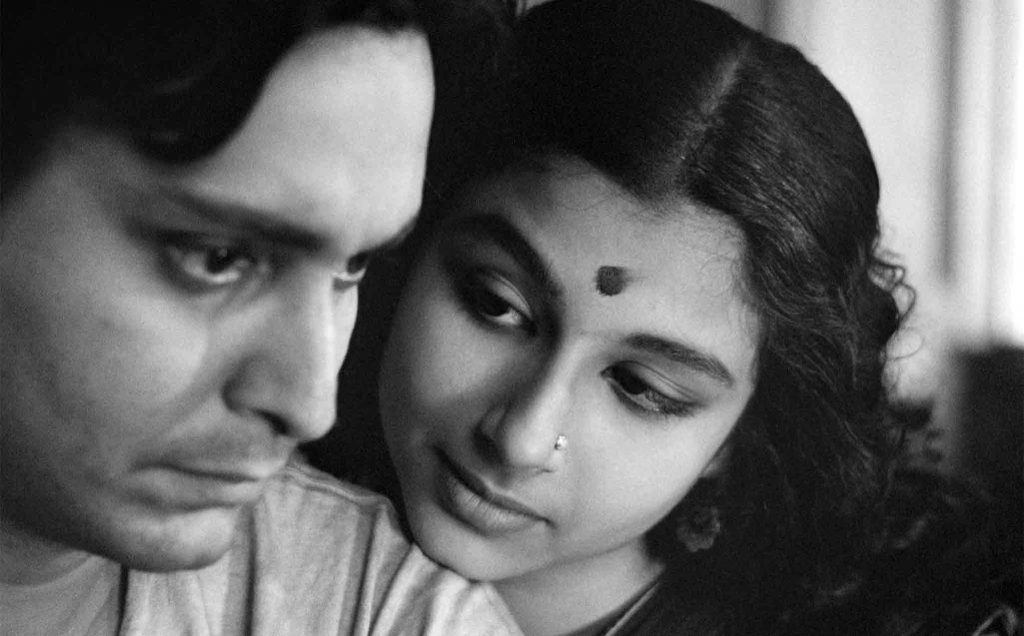Trilogy Anatomy: The World of Apu, by Tober Corrigan
15 Jul
Upon being asked after the release of the Dark Knight if he had a third installment planned, Christopher Nolan replied with asking ironically how many good third movies there were. Of course, Nolan eventually did complete his trilogy, whether it being against his better judgment or not depending on who one talks to. Throughout movie history, the essential functions of the third film in a series have either been as a fitting and satisfactory end to a particular storyline (Lord of the Rings: Return of the King), a disappointing but nevertheless conclusive entry (Godfather III), or a debacle so big as to necessitate a reset to the franchise (Superman III/Spiderman 3, etc., etc.). In anticipation of another highly-anticipated third film, War for the Planet of the Apes, this weekly series will cover famous third films, infamous third films and otherwise, exploring how trilogy-enders or other types of third films have functioned in relation to its series.
If I have learned anything from this trilogy series, it is in how miraculously inevitable one or two sequels can feel to the overall story arc even if they were at one point never supposed to be made . Filmmaking is one of the more expensive (in money, time, and manpower) of the arts, requiring significant financial backing and public approval to get any one particular iteration of a character, let alone several.
Satyajit Ray, director of the Apu trilogy and father of Indian cinema for most Westerners, proves the thesis that little miracles can be woven out of the otherwise unintended. Born into a family of artists, Ray tried filmmaking much later in life, only after many other artistic exploits. His first film, 1955’s Pather Panchali—a meandering two-hour poetic adaptation of a popular Bengali novel, following young Apu through his voyeuristic younger years as he grows up amidst strong and contending women figures and learns about the essences of life from them—came together only after a grueling, multi-year shoot . The film garnered a Cannes prize and a significant run in the New York theater circuit. A film he just hoped would get a release became much bigger and more impacting than he could have ever hoped.
Such success allowed for an immediate sequel, Aparajito, picking up emotionally where the first left off, and proving in the process to be as beloved. A trilogy would have never been made if not having it suggested to Ray during a conference at a Venice film festival. To watch Apur Sansur (or The World of Apu), one would never believe Apu’s heady, torturous, and ultimately life-affirming adulthood was at one point a vision claimed by no one, hovering alone in the ether. As a collection of work, this Apu trilogy is mighty, a major testament to the power of using form to express the passing of time and childhood.
Apu’s emotional journey is affecting, and remarkable cohesion exists among the four different actors playing the title role, offering a shape both lifelike and timeless. The emotional identification that comes with seeing someone grow up, go to university, find loved ones, and lose loved ones is part of the reason for the compounded resonance experienced by the final scenes of The World of Apu. The impression is very much built by design.
World of Apu starts with Apu recently graduated and looking for work. Through humorous interludes, we see him either woefully overqualified or without the relevant experience to land a job. These downtrodden beginnings are treated lightly here, despite all the baggage of dead family members from the previous films. The World of Apu is somehow both the most wizened and the least self-serious of the series.
In fact, all three films take on the essence of whatever age Apu is in at that moment. Pather Panchali is the most wasteful film of the series, settling on several extended sequences of running and playing and getting into mischief, all of which have no direct bearing on the lives of the parents, who really drive the narrative. The camera lingers, explores, and settles, looking to capture a myriad of transcendent experiences in every possible free moment. Aparajito is just as restless, but the movement is focused and tinged with previously unfounded tension. The family moves from city to country, then Apu from country back to city. Apu, and the viewer, feels caught between the two shores of family and school, and the allegiances both demand. The cord is run taut, and then a death releases the tension, deflating both Apu and the viewers’ mood to a somber, mellow glow.
The World of Apu, in contrast, comes out exacting and economical. Scenes are just as long or short as is necessary, allowing for gliding, masterful shots that are both beautiful and entirely devoid of pretension. Some would argue this is Ray becoming a better filmmaker. I simply believe it’s just him getting, like Apu, more familiar with the world around him. The World of Apu is both the director and the character at their most professional.
It also happens to be the funniest of the three. A major inciting incident involves Apu being invited to a wedding in which he ends up being the bridegroom. Apu himself remarks (and distastefully at that) upon the event being something straight out of a novel, creating an ironic contrast with Apu’s pompous declarations on the importance of the novelist earlier in the film. Apu both does and does not want to live a life that can come from books, the sort of contradiction the artistically-minded can respond to and revel in. Apu comes to love his arranged wife, and it happens rather haphazardly through teasing and mocking, little games only the two can learn to appreciate in each other. The humor here is genuinely funny, not contrived in the childhood way Panchali often settles for.
Even the film’s pathos, powerful and present, is less maudlin and more reserved than that of the first two. Apu’s cinematic life is characterized by death, with each film having at least one major character meet their end, usually by disease or sickness. The death of Apu’s sister in Pather Panchali is both sudden and unforgivably slow. The film does not prepare us for it. In fact, the film turns an ethereal moment (that of Apu’s sister being cleansed by a rain storm) on its head (her catching a cold that leads to a fatal fever). Her death is inexplicable, and quasi-mythical because of it; a fairy-tale purity surrounds her death like a halo. This immature but aesthetically-intriguing treatment reflects childhood Apu, who can only conceive death through refracted light. The deaths of the two parents in Aparajito are given very demonstrative cinematic cues, using nature to overtly symbolize the giving up of spirit. Apu’s father’s death is contrasted with a burst of pigeons taking off into the pure sky. Apu’s mother loses her life quietly, with her spirit left roaming among the countryside fireflies.
But the death of Apu’s wife in The World of Apu happens halfway through and without preamble. It is the most real death in the trilogy, because it happens off-screen and with most believable causation (childbirth). There is no poetic imagery. There is no romanticism. Apu’s resultant grief is played with great realism as well. He moves through his life with nary a sound or gesture, finding himself unaffected by those around him. The world does not cry out in Biblical groan pains (or at least the camera does not linger on it) the way it does in the first two films.
But Ray’s project here is not nihilism. In fact, this is the only one of the three films that ends in reconciliation and peace rather than in death and tragedy. It ultimately becomes a very humanist drama of forgiveness, letting go, and the virtue of embracing new life (or any life) in the face of the greatest injustice. These moral attitudes are nice touches, and are imbued enough through character to avoid being preachy. The film is both the most frank and the most fulfilling of the three, because, like Apu, it grows in age and experience, stripping away the rose-tinted glasses along the way. To be rid of childish things is for Ray the path of greatest resistance and of greatest reward. For, like the miracle that is this series, Apu’s life begets new life. He gains a son even as he loses a wife. We, like Apu, are required to accept the fated narratives and formalistic transformations woven throughout this most unexpected of journeys.
This trilogy is a flower. Find its recent re-release in the Criterion Collection; watch it bloom for yourself.





No comments yet